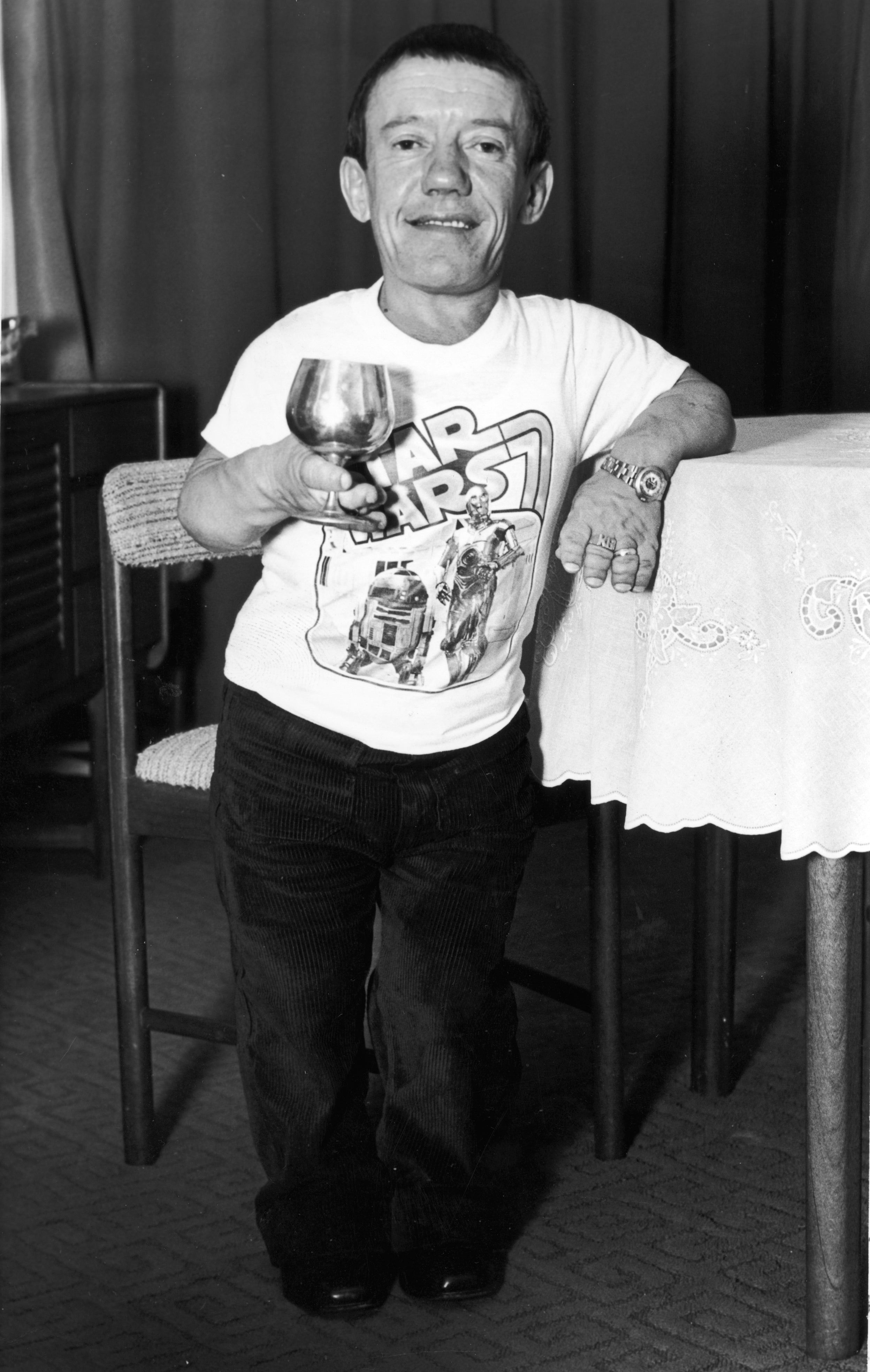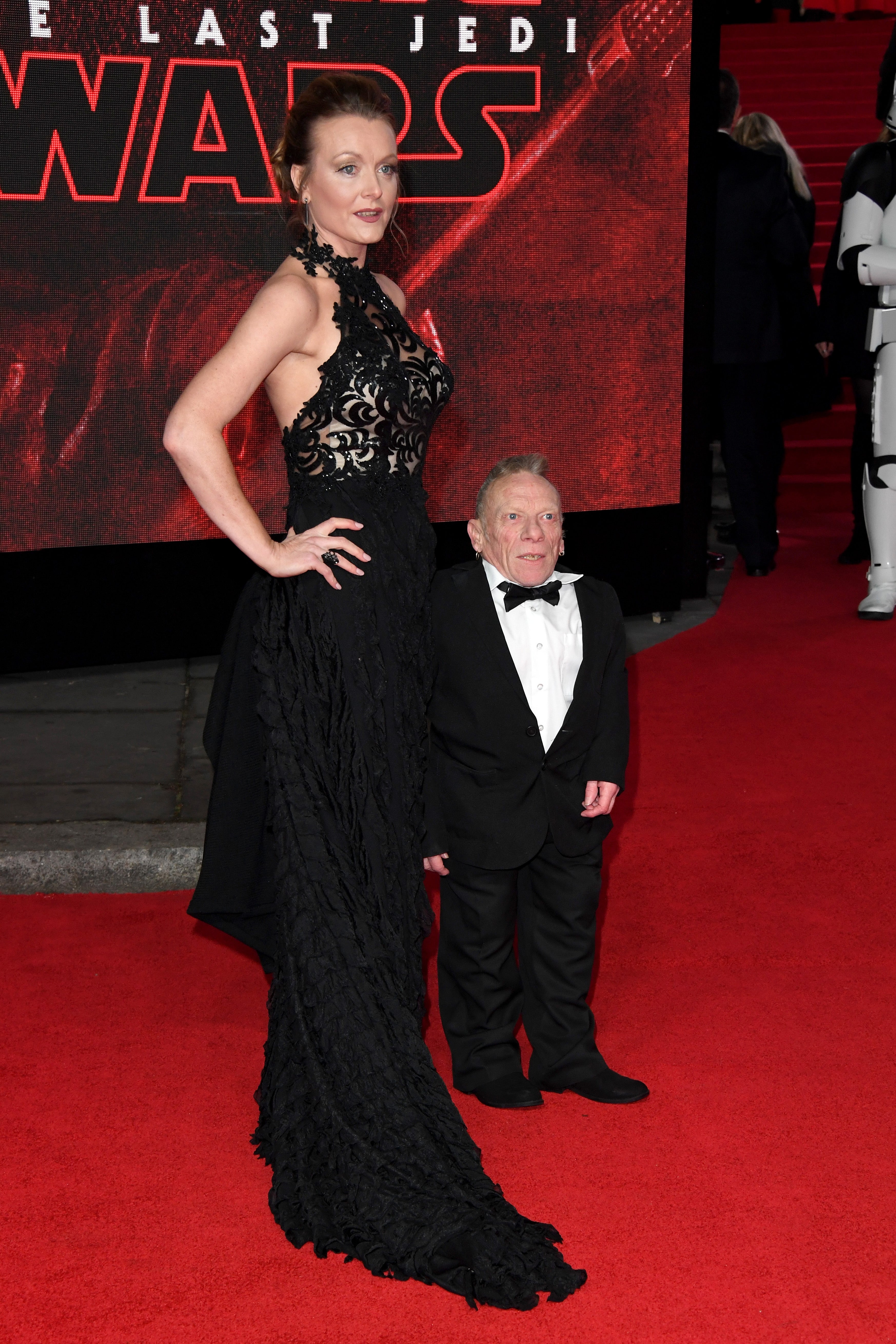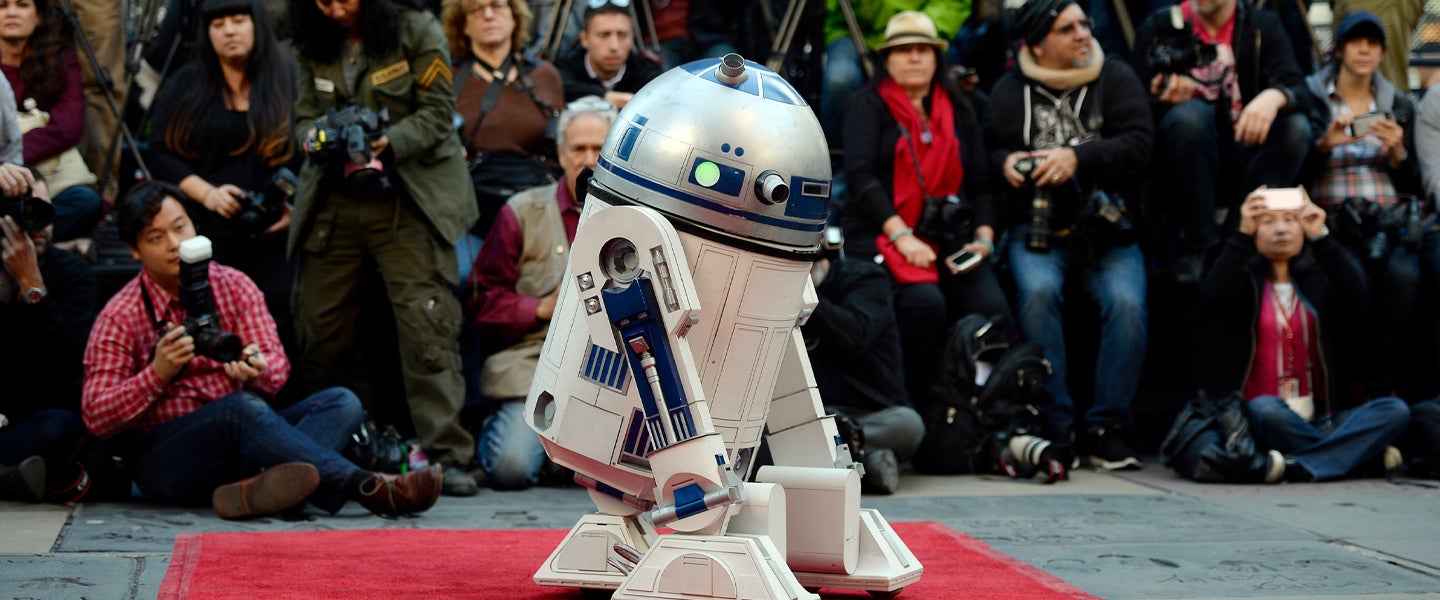When Kenny Baker died in August 2016, Star Wars fans grieved the loss, even if it would be overshadowed by the death of Carrie Fisher just a couple of months later. Baker, like Fisher, was one of the originals: He had faithfully portrayed R2-D2 for just shy of 40 years, starting with the 1977 original film. R2 was always a standout character, even if the man under the dome was sometimes overlooked.
In the 1970s, the need for an actual person inside of R2-D2 was purely practical. Robotics existed back then, but they were still crude and could only execute some of what R2 needed to express. Ryder Windham, author of dozens of official Star Wars books, including Star Wars Omnibus: Droids, explains to me, “George Lucas was frequently frustrated with the remote-controlled R2-D2 props during the production of the first Star Wars movie because the prop rarely operated correctly, veering in the wrong direction, stopping short for no apparent reason and so on.”

“Relatively, Lucas found Kenny Baker easier to direct,” Windham continues, adding that, “I’m sure having a human operate an R2-D2 costume is partially an economic decision too, as a costume is probably more durable and requires less maintenance than a technology-laden prop. Whenever you see R2 on screen with his third leg extended as he moves across the ground, that’s R2 as a remote-controlled prop, not a costume.”
One of the many things that the robotics of the time couldn’t do was “wobble.” As Windham explains, “The original R2-D2 costume/prop for Star Wars had a removable dome that allowed Kenny Baker to climb in and out, and also a seat for Baker. Grips inside the costume allowed him to rotate the dome, and also to help maintain his balance as he threw his weight back-and-forth for scenes that required an ‘excited’ R2 to wobble.”
While it may not seem like much, any Star Wars fan knows exactly the “wobble” I’m referring to. Along with the beeps and blips generated by sound designer Ben Burtt, that wobble is what made R2-D2: It gave him spunk and personality that was unachievable at the time without a man inside the suit.
Still, it wasn’t without its challenges. Windham says, “Kenny Baker’s experience was that the R2 prop/costume was cramped!” Baker himself shared in interviews that he was initially skeptical about being stuffed into a robot, and ended up having to contend with getting scabs on his head from the screws in R2’s dome, as well as getting wires tangled around his neck from the dome spinning. Also, people would forget about him on set when they broke for lunch.
When it came time for the prequels some 20 years after the classic trilogy ended, Baker was brought back, though his role was reduced in favor of CGI and more advanced robotic models of R2. At this point, it’s hard to say if Baker was really needed in these films or if George Lucas brought him back out of a sense of tradition, but fans no doubt welcomed his return, as R2 does have some memorable moments in the prequels, even if some of the CGI scenes got heat from the fans (like him flying, for instance).
R2-D2 has just one real scene in The Force Awakens, so it’s no surprise that Baker wasn’t brought back for that one, instead being merely credited as a “consultant.” Baker was also in his late 70s by this time, and it was likely unwise to put anyone that age into a metal container. With the passing of Baker in 2016, it would have seemed natural to end the practice of putting a man in there altogether, yet actor Jimmy Vee was named as his replacement in 2017 (it was also revealed that it was he who had played R2 in The Force Awakens, though Vee went uncredited in the role). Thanks to Baker’s consulting and friendship with Vee from movies like Time Bandits, in which they co-starred, Vee learned the ropes (or rather, wires) from Baker himself.
While it’s nice to know there was an official torch-passing from Baker to Vee during The Force Awakens, there’s still something a bit troubling about the idea of the role being continued in this way — an almost “carnival-like” aspect. While I wouldn’t wish for anyone to be out of a job, putting a human being in what is essentially a garbage can seems at worst cruel and, at the very least, unnecessary. But, as a guy who stands 5-foot-11 — but who often lies and says he’s 6-foot — who the fuck am I to judge?

Still, I wanted to better understand what is clearly a complicated situation, so I reached out to little person actor and activist Sofiya Cheyenne to discuss the issue. Cheyenne explains that roles like this — as well as ones where little people play things like elves, gnomes and leprechauns — are a bit of a complicated issue in the little people community. “Personally, I never judge any other little person who takes these roles,” says Cheyenne. “I get how hard it is out here, and quite honestly, these are the only roles that we’re offered. But I believe that there’s this corner that we’re stuck in as a community. We’re often portrayed in these stereotypical roles that are usually non-speaking characters, and oftentimes we’re in costumes that cover our faces.”
Cheyenne says that there are a few little people who have broken this mold, citing Peter Dinklage and Meredith Eaton as examples, and while she does notice some progress in the entertainment industry, it’s minor. “We’re the last minority where it’s okay to laugh, it’s okay to point and it’s okay to take pictures of us. We’re the last minority to be seen. No other disability is still subject to this, and I believe part of this is because the media has perpetuated this notion that we aren’t human.”
Even the status of a little person as being disabled is something of a debate, with some feeling the status doesn’t apply. Cheyenne explains that there are about 400 different skeletal dysplasias that can result in dwarfism, and because of this, they face a wide array of different needs. “I was in the hospital every summer as a kid getting surgeries,” Cheyenne shares. She also cites some of the daily challenges that she faces: “I have to navigate this world differently, and while the ADA [Americans with Disabilities Act of 1990] is great, it doesn’t help little people a lot of the time. Like, ADA-compliant bathrooms make every sink and every toilet higher. Also, just having a hook for your coat or getting coffee stirrers at Starbucks or being seen at a deli counter — it’s all difficult for us and it’s everywhere. I’m not saying everything has to become low, but if people just look at us in the eye when we’re ordering our food, that makes a difference. As for the media, we have to push to be seen as real, human characters.”
It’s not all black and white, of course — there are some roles where little people play an elf or a leprechaun that have some real depth to them (Cheyenne cites her friend Danny Woodburn as an example) — but more often than not, the roles they get are non-speaking or overly aggressive. Even Dinklage played into this in Elf, where he beat up Will Ferrell, and Woodburn did too in Seinfeld, when his character would attack Kramer. The trope of “little person attacks big person” is a fairly common one, and one that Cheyenne thinks hurts her community. “I’ve gone for several roles where I’ve been asked to bite someone,” she relates.
For herself, Cheyenne says, “I personally seek to break the mold and not accept roles like that. That is my choice.” She does say that if something feels “circusy” to her, she’ll always read the whole script and give it a chance. She also encourages little people to advocate for themselves and speak up. “You can always say, ‘I’m not sure if my character should bite this person,’” she says, adding that doing this sometimes opens the eyes of those in charge to see how this is offensive. “I know that Danny Woodburn has done this with a number of his characters.”
Cheyenne says that she has a personal credo when it comes to auditioning: “My mentality is that I’m going to go for the audition, I’m going to book the role and then I’m going to try to change their minds.” She also notes, “I don’t want to take those roles away from little people either, because they do provide work and this business is hard — I just want to live in a world where that’s not my only option.”
As for R2-D2, Cheyenne’s personal opinion on the matter is that, well, it really is complicated. “R2-D2 isn’t human, he’s a computer, so it’s hard to compare in this context. He’s a compelling character that often saves the day and helps the good guys, but it’s the skill of the computer that you see, not the actor inside that suit. I think R2-D2 is in the gray area because we don’t really acknowledge that there’s a dwarf inside. But I don’t think I’d consider it offensive because it’s not a knock on people with dwarfism. What’s offensive to me is movies like Leprechaun or elf roles that have no humanity to them.”
Indeed, it seems to be his humanity that is R2’s saving grace. While Cheyenne says that it’s difficult to compare here, the man himself, Jimmy Vee, tells me, “When there’s someone inside of it, it gives it a soul.” Windham concurs, adding, “I think human actors add something to the character. They help make R2 more lively.”
Vee goes on to say, “You relate to someone being inside the machine, rather than just having CGI or someone pressing buttons. Someone inside gives him a life.” In other words, Vee believes that the very reason we love R2-D2 so much is because there’s a man in there — even if we don’t see that man, we feel him and sense his presence.
If you consider the many computer-generated Star Wars characters that have come since, few have really caught on the way R2-D2 has. While it’s too easy to shit on Jar Jar Binks, perhaps the reason we didn’t take to him is because we knew he wasn’t really there, and while guys like Andy Serkis have helped bring humanity to computer images, many people — myself included — still feel more connected to a puppet. That’s why, despite the notorious online backlash to The Last Jedi, many fans applauded a return to a puppet version of Yoda, especially after he was unnecessarily portrayed as CGI throughout the entirety of the last two prequels. For R2, one could argue that this character needs a human presence even more than a CG character does, because R2 doesn’t really have a voice to relate to. You want to feel him and feel for him, which is why scenes like him flying through a CGI factory didn’t go over: Fans felt the difference.
Now, the obvious elephant in the room here is BB-8. After all, BB-8 is adorable and widely loved — while some diehards may dismiss him as overly cute, most Star Wars fans have embraced the little guy. Still, I don’t know if they relate to him as they do R2. As Vee explains, “Don’t get me wrong, everybody likes BB-8, but at the end of the day, it’s just a ball with remote controls. When you’re on set, you can’t drop down and have a conversation with it, but with R2, you can.” To that point, there’s still something about R2-D2 that feels very much like old Star Wars. He feels clunky and cumbersome and imperfect. He feels, well, human.
While it’s hardly luxurious in there, Vee says that he’s not uncomfortable inside of R2. “It’s actually okay,” Vee assures me, despite also admitting that R2’s insides have changed very little since Kenny Baker’s day, and that it’s like playing hide-and-seek in a tight closet, where everything is muffled on the outside. Vee’s feet are on the ground, inside R2’s feet, and he has two little handles to grip, which allows for him to achieve R2’s distinctive wobble. “When it’s excited, I do the sidey-ways shake, or if it’s angry, I bounce it up and down. To turn the head, I reach up and I’ll get directions like ‘10-o-clock’ or ‘2-o-clock’ from the director.” Aside from that, he can’t really move: “I can sidestep a little, but when I played MPH-11 in Solo, I could actually walk around.”

Still, Vee says, “it becomes part of you.” As a friend of Baker’s, he’s honored that he gets to carry on the role and has received a great deal of encouragement from Baker’s family. As the future is unclear for Star Wars after The Rise of Skywalker, so too is R2’s fate as a practical effect. “I don’t know what will happen in the future,” says Vee. “You can do almost anything nowadays with computers, but I’d like to think, no matter what happens, they keep somebody inside of it, because it needs a life.”
Finally, Vee adds that if Skywalker is his last go as R2, he’s grateful for the time he’s had to portray him, remarking, “As I say, you can take away my can, but you’ll never take away my glory.”

